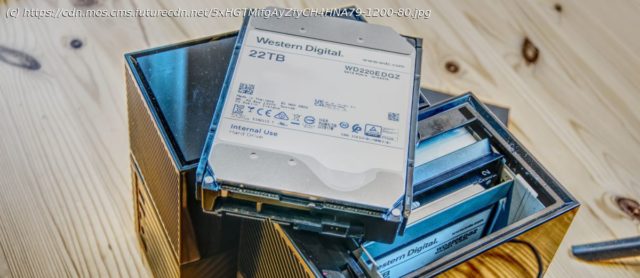The WD My Book Duo 44TB offers a huge amount of offline capacity, but the performance limits how it can be used.
WD My Book Duo 44TB: 30 second review
The Western Digital My Book Duo series first appeared in 2012 with the My Book Live Duo, the first of this series to combine two drives for extra capacity or resilience.
While single-drive My Book designs are still prevalent, the Duo, with its ability to have the drives replaced or upgraded, offers a tempting option for those that want plenty of capacity connected to their systems.
The latest option, the one with 44TB emblazoned on the box, comes with two WD220EDGZ 22TB drives pre-installed into what looks like the same box that we’ve previously seen with a wide range of options that include 16TB, 20TB, 24TB, 28TB, 36TB and now 44TB.
For those wanting the best value options, we’d suggest the bottom two sizes. The worst cost per TB is the 28TB design, and the new 44TB option is only slightly more expensive per TB than the 20TB model.
Connecting via USB 3.2 Gen 1 (5Gb/s), the two 22TB drives can be configured as JBOD, RAID 0 (performance) or RAID 1 (Mirrored). JBOD connects the drives individually as two 22TB drive letters, RAID 0 as a single 44TB drive with improved performance, and the Mirror option lowers the capacity to 22TB but can survive one of the drives dying without data loss.
The critical takeaways of this new model are that the capacity is so great that it would take 31 hours or more to write the whole volume of data over USB. And Western Digital will inevitably release an even bigger one when even larger mechanisms become available.WD My Book Duo 44TB: Price and availability
How much does it cost? $1500
When is it out? It is available now
Where can you get it? You can get it in most regions through online retailers.
Typically with Western Digital, we’d mention the company’s online shop to source these types of items since this is most likely to have stock. However, at the time of writing due to a ‘Security Incident,’ the selling part of the WD website doesn’t function.
Hopefully, this will be resolved in the coming months, but for now, online retail is the only source for this or any WD-branded products.
Direct from Amazon.com, the 44TB Duo is $1499.99 (opens in new tab), and in the UK, the cost is £1,756.39 (opens in new tab), which seems excessive. As you can get the 36TB Duo for £879 in the UK and the 24TB Duo for $586 in the USA, there are numerous ways to get more than 44TB at a lower cost than $1500. Although having multiple Duo’s isn’t as convenient.
Currently, the largest desktop drive Seagate makes is a 20TB model. However, with Ironwolf drives with larger capacities now available, these are likely to be introduced to the Seagate Expansion series in the coming months.
A 16TB Seagate Expansion costs just $250, which equates to 96TB in six drives for the same money as the 44TB Duo.
Western Digital’s SanDisk Professional brand offers the same drives but in a superior enclosure with Thunderbolt connectivity for $750 for the 20TB single-drive model. That’s an equivalent cost per TB, but the all-metal enclosure and Thunderbolt connections make it an alternative option.
A high price is expected at launch for the new flagship Duo, but once some direct competitor products are available, the price is likely to go down.
Value: 3/ 5WD My Book Duo 44TB: Design
Looks like every My Book Duo
Bigger drives and PSU
Still noisy
In my office, I have a 12TB Duo (dual 6TB drives), and from the outside, these units look the same, even down to the finest details.
They share the same black sculpted box with a flat gloss surface at the top and
a rippled silk finish on the lower half. On the back are two USB 3.2 Gen 1 ports that are part of an internal hub, the USB-C port that connects the drive to the host computer and a Kensington security slot.
It’s tempting that based purely on appearances, the 44TB Duo is identical to the old 12TB model, although other than the drives, we did notice one significant difference.
The 12TB model uses a socket PSU rated for 3A at 12V (36W), whereas the new unit uses a laptop-style PSU rated for 4A at 12V (48W). The PSU chosen reveals that the 22TB drives consume more power, and the original PSU design was insufficient for these larger-capacity drives.
A little research reveals that the larger PSU comes with Duo’s of 16TB or bigger, and that infers it might be a bad plan to get a 12TB or smaller Duo and put 22TB mechanisms in it.
Perhaps WD could develop some way of enabling owners to identify the model more easily from the outside, maybe a colour-coded label. Because if you have a line of these connected to a system, it would be impossible to work out the installed capacity without either opening them or getting a magnifying glass on the tiny labels.






